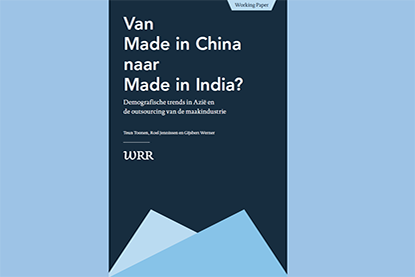Demographic developments abroad affect the Dutch economy and trade
Significant demographic changes abroad can impact trade flows to and from the Netherlands. The working paper From Made in China to Made in India? Demographic trends in Asia and the outsourcing of manufacturing (Dutch title Van Made in China naar Made in India? Demografische trends in Azië en de outsourcing van de maakindustrie) was written by the Netherlands Scientific Council for Government Policy (WRR), while the OECD published a study titled Assessing the impact of long-term global demographic changes on the Dutch economy and trade.
Both publications focus on how demographic developments abroad can affect the Dutch economy and trade. The background studies were conducted within the WRR project The Netherlands in an aging world which examines the impact of a globally aging and shrinking population on the Netherlands. The advisory report is expected to be released in 2025.
Production chains
The Working Paper From Made in China to Made in India? describes how China rapidly emerged as a manufacturing and export powerhouse starting in the 1990s. A large part of the manufacturing industry in the Netherlands and other Western countries was outsourced there. This led to lower prices in the Netherlands and gave China a central role in global production chains — many intermediate products for our industries come from China. This development was largely possible due to China's rapidly growing, young workforce. The paper shows that, in the coming decades, aging and population decline will create much less favourable conditions for China to remain the "world’s factory." Are there alternative countries that can produce the goods the Netherlands currently imports from China? While uncertainties are high, regions in Southeast Asia and India offer potential. These areas are expected to experience a "demographic dividend" over the next decades, with a relatively large working-age population compared to the total population.
Trade flows
The second study, commissioned by the WRR and conducted by the OECD, places these developments in a broader context. It not only looks at imports, but at all trade flows to and from the Netherlands. This is done using a quantitative model that maps how future changes in global demographics could lead to shifts in trade patterns to and from the Netherlands. It is expected that imports to the Netherlands from China and Germany will decline, while imports from the United States and Southeast Asia will become more significant. This is linked to the fact that, while China and Germany are aging and shrinking quickly, the working populations of the United States and Southeast Asia are expected to remain stable or even grow. For Dutch exports, the importance of Germany is likely to diminish in favour of the United States and emerging economies in Asia and Africa. These countries will become more important as export markets because of their demographic growth. Such shifts in international value chains are especially relevant for sectors that are relatively labour-intensive. Some sectors of the Dutch economy will therefore be more exposed to demographic changes in other countries than other forms of economic activity.
